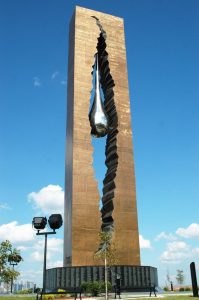- Author
- Letter Writer
- Subjects
- History - general, Letter to the Editor
- Tags
-
- RAN Ships
- None noted.
- Publication
- December 2019 edition of the Naval Historical Review (all rights reserved)
Almost coincidentally we recently received correspondence from two readers, Megan Hughes and Tony Maskell, asking if we had knowledge of the 9/11 Boatlift Memorial in New Jersey. We trust the following explanation may interest to other readers.
Dunkirk and evacuations on the fall of France
The epic story of the evacuation of British Expeditionary Force from the beachhead of Dunkirk (Dunkerque) from 26 May to 03 June 1940, where they were trapped between an advancing German Army and the sea, is well known to all students of the history of the Second World War. Dunkirk, a small port near the northern border of France and Belgium, did not have facilities to accommodate large ships so an assortment of about 800 vessels, some naval but mostly civilian ferries, pleasure craft and fishing vessels made passage from England and then returned with as many men as they could cram aboard for the 40 nautical mile return voyage. About 366,000 Allied troops were safely evacuated but a large number, mainly French, fell into captivity.
The ‘Miracle of Dunkirk’, thought to be the largest seaborne evacuation of personnel in modern times, was not the end of the evacuation from France as many more Allied forces were stranded by the blitzkrieg, of mobile infantry and armour perfected by the German forces. Over the next few days further hasty evacuations were made from the north coast of France, culminating with those from St Nazaire on the Loire River during 16 to 18 June. It is estimated that a further 192,000 Allied troops were rescued during this period, making the total uplifted from northern and western France about 558,000. There were, however, about 69,000 Allied casualties who were killed, died of wounds, were missing or taken prisoner.
The New York 9/11 Boatlift
Surprisingly there are considerable similarities between these historic events separated by more than sixty years. The first occurred in northern France during May/June 1940 and was followed by the infamous ‘9/11’ terrorist attack on New York’s World Trade Centre on 11 September 2001.
As the scope of the calamity following the explosions at the World Trade Centre unfolded, in collaboration with municipal authorities the State Police placed Manhattan Island in lockdown. Buses were halted, subways and commuter rail systems were shut down and bridges and tunnels closed to prevent the likelihood of further attacks.
As civilians raced to the shoreline what began as an expanded ferry service quickly escalated into a full-blown seaborne rescue where anything that floated came to the assistance of evacuees queued up to ten deep along the Lower Manhattan foreshore. By nightfall, over a nine-hour period, it is estimated that about 150 vessels comprising ferries, tour boats, fishing vessels and pleasure craft, crewed by about 800 mariners, had executed an amazing boat-lift of about 500,000 people with very few incidents or serious accidents.
In the case of Dunkirk, the boats had to cross the English Channel and avoid enemy ships and aircraft in their dash for safety. In New York, for many, it was less than one mile across the Hudson River to the safety of New Jersey and then the vessels could return for more crossings. Dunkirk was a coordinated wartime evacuation controlled by the Royal Navy but with mostly civilian craft under attack from land, sea and air. New York was a peacetime emergency loosely coordinated by Coast Guard and Police and was almost fully organized through the use of civilian craft. In 1940 and again in 2001 when the call went out for assistance the brethren of the sea came forth and mariners were not found wanting.
9/11 Memorials
A well-known 9/11 pool of remembrance memorial and museum is now a feature of the Lower Manhattan landscape. Less known is another memorial to the same event presented by President Vladimir Putin on behalf of the Russian people to the people of the United States in 2006 known as the Tear Drop Memorial. This stands on the site of a former military ocean terminal at Bayonne New Jersey, across the Hudson River opposite the site of the World Trade Centre. The controversial artwork by Russian sculptor Zurab Tsereteli shows a cracked façade forming an image of the two towers. In between a giant suspended tear drop symbolizes all the tears that have been shed in response to this terrifying day. At the base are recorded the names of all the people who perished.
Further information is to be found on the following website: https://insh.world/history/the-great-boat-lift-of-911/





